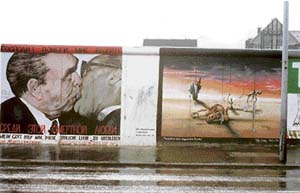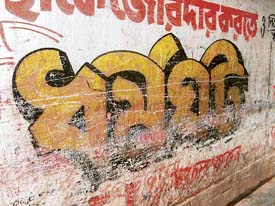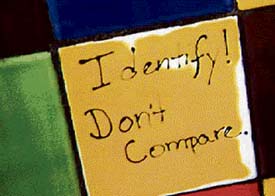|
Writings on the wall
Graffiti is
much more than random scribbling on the walls. From the 1960s
onwards, when it started as a socio-political movement, it has
evolved into an art form. Shoma Chatterjee
looks at the history and evolution of the graffiti culture
We to wonder, O Walls,
That you’ve borne your burden so bravely,
Under the weight of the words scribbled all over your face. — Allan Dundee |
Does
graffiti deface the beauty of a city? Or is it an art unto
itself? Wall art and wall writing is considered to be a form of
art in the West. Graffiti is the act of inscribing or drawing on
walls to send out a message to the masses. The term comes from
the Greek Graphein, which means ‘to write.’ Graffiti
has been around since men first started drawing pictures in
caves. Since the root of the word "graffiti" is
"to write," graffiti can be interpreted as an
instinctual human need for communication.Mark Ferem says that graffiti
is the plural of the Italian graffito, which means
incised inscription or design, an ancient drawing or writing
scratched on a wall or other surface.

The Berlin Wall was one of the world’s best-known places for graffiti. The creative expressions ranged from art, politics and peace to nostalgia. The visual, a kiss between Leonid Brezhnev and Erich Honecker, parodies the Soviet grip over East Germany.
— Photo by A.J. Philip |
"Graffiti
dates back to a million years. The first documented evidence of
New York City graffiti was in the mid-1960s, when a youth,
"Julio 204" began to write his tag in the subway
system. By 1968, his name was right across the city. The same
year, Demetrius, a Greek boy, began scribbling "TAKI`A0
183." "Taki" was his name and 183 was the street
he lived in. He was a foot messenger and would scribble his name
in motion tags. This made many people curious and soon everyone
was doing it. Each one developed his individual style to gain
recognition," says Diya Sarker, a graphic designer, an avid
collector of graffiti. A New York Times reporter tracked
down and interviewed Taki 183, subsequently publishing an
article entitled "Taki 183 Spawns Pen-Pals." The
article had a snowballing effect as hundreds of writers turned
to the streets to express their feelings on all walls everywhere
in the US.
Types of
graffiti
Hip-hop
graffiti can be roughly broken up into three different types:
Tags, throw-ups and pieces. A tag is someone’s name written
anywhere. It is usually done in a single colour, many times with
pens. Throw-ups are also known as outlines or fill-ins. These
are simple ‘pieces’ done with two three colours (black and
white mostly, or silver and black). Pieces are multi-coloured
pieces of art that everyone loves to see all over the city. They
are the highest evolution of hip-hop graffiti.
Art form
Graffiti has
never evolved into any kind of art or literature in India. It is
considered a scar on the urban landscape where walls are
indiscriminately appropriated by one and all for purging their
suppressed desires, unfolding their sad souls or, most
importantly, for political sloganeering and propaganda by
political parties.
Walls in India
– building walls, boundary walls, fencing walls along the
railway tracks, walls bordering off the airport from the rest of
the city, walls of public transport, every public wall define
the large, nameless proscenium for the drama of cheap
advertisements to unfold. They throw up that magic remedy for
infertility or male impotence or a cheap trip abroad. Though
vandalism and graffiti derive from very different motives and
environments, the line between the two is too fine sometimes to separate them.
In India,
graffiti is either only vandalism, or political and commercial
propaganda. Restroom walls and classroom walls, desks and
benches in schools and colleges, are comparatively private areas
where the graffiti artist can let himself go. Though graffiti
writers and artists prefer to remain anonymous, some of them
sign their names in the hope of recognition. It began and still
is, a ‘class’ act, as it was born among the slums and
low-income ghettos indulged in by those who could draw and paint
and those who could write in style. Those who first began the
hip-hop movement were at the bottom of the socio-economic
pyramid. The founders of hip-hop were not born into wealth, but
were actually expressing their jealousy towards those who were.
Devon D.
Brewer, a sociologist, claims "there are four major values
in hip hop graffiti: fame, artistic expression, power and
rebellion." The other three values are fairly unique to
hip-hop and symbolise the envy of alienated and frustrated youth
whose frustration stems from and feeds on isolation from the
mainstream and deprivation of material good.
Valeria Appel,
in Ghetto Art – Thousand Voices in the City, writes:
"The graffiti subculture is a system of action that
renegotiates the social significance of public space. The city
is a structured space that mirrors social, economic and cultural
forces in its organisation and architecture. The city is a place
in which markers of identity and collective meaning are
displayed and exhibited in a democratic space. `85 The first art
form born in the slums responded to the political conditions of
the city. Street signs, lights, cinema, theatre billboards and
advertising among others made up a permanent display of
messages, names and images acknowledging the existence and
significance of particular elements in the visual
landscape."
But graffiti
has since moved out of class borders to step into the
mainstream. The explosion of hip-hop style in the 1990s brought
graffiti to an entirely new range of artistic and creative
people. Sussan Farrell has created a wonderful website dedicated
to graffiti.This is an FAQ on graffiti. Tim O’Neil is an
artist who is paid to cover up graffiti. Within 24 hours of
getting a call about new graffiti, O’Neil covers up the work
and replaces it with something he feels is more aesthetically
pleasing. Mark Ferem, a freelance writer and photographer based
in L.A. runs a website http://www.itsallinthehead.
com. The site,
a study of restroom graffiti, is dedicated to Allan Dundee who
coined the word Latrinalia in 1966 to refer to graffiti
found in restrooms in his essay, Here I Sit: A Study of
American Latrinalia.
Kolkata calling
Calcutta
perhaps, can easily qualify as the graffiti capital in India
both in terms of style and design as well as in terms of the
slogans it spouts forth on the city walls. Though most graffiti
writers here are anonymous, there is one exception named K.C.
Paul. "His graffiti(scribbling) is the only one that amuses
me," says Diya who has photographed quite a few graffiti by
this prolific graffitist. According to him:
The sun goes
around the earth once a year.
There is no
life on Mars because Mars is not stationary like the Earth.
All Scientists
are fools.
He draws
diagrams that show the earth in the centre with all the planets
and the sun rotating around it. He draws Mercury and Venus
rotating around the sun like moons. Graffiti is random. Its very
randomness defines the lack of a pattern or design, or
organisation, each graffiti a stand-alone articulation of the
writer or artist’s random thoughts. It has nothing to do with
any given issue or problem. Graffiti artists can easily be
recognised from their individual style. It is a part of human
nature to want to have people recognise or hear you out.
France offers
the best example of graffiti as beautiful art. Jerome Mesnager
is a graffitist who has raised graffiti art to high levels of
creative and aesthetic excellence. He creates masterpieces.
There is no text to support the artwork but the wall becomes an
integral part of the total design, each unfolding its own story.
"Like most
developing countries, graffiti in India is used mostly for
commercial, political and religious reasons. This kind of
graffiti interests me only in the style of writing, colours used
and locations chosen to get the message across. But this exists
in all developing countries with lenient laws; I feel this is
because it is the cheapest form of advertising. I have not yet
seen Indians take it to the next level except for a few college
students. But no one has taken to the streets like a rebel and
left his artwork with his/her style. The regular scribbling and
scratching of names can be seen everywhere. I have done a bit of
sticker posting myself. This has developed from the American
style of graffiti of trying to get a message across. You can use
chalk, sketch pens, felt pens, marker pens, stencil, crayons,
spray paint and stickers as your tools. Instead of spraying
something on walls and buildings, you stick a sticker instead.
The sticker might be anything, a funny picture, or the name of
some organization. The sticker my friend gave me had "Waste
Your Life Be An Artist" written on it," says Diya.
The people of
West Bengal are passionate about politics. Graffiti is the heart
and soul of this passion. We would love to see cleaner city
walls. They will support a ban if the government is successful
in implementing one. One would rather see graffiti than walls
full of spit marks. If in the future, the main streets and
highways in the cities of the state can strip the walls of
graffiti, but we will always see graffiti in the poor parts of
the city.
In India most people look at it
as a nuisance because it ruins the beauty of their surroundings.
But people don’t make paintings here. They write names of
political leaders, advertise for this and that product, so it is
not something that lends itself to any kind of cultural study.
But there is a lot of graffiti at the site of the Bhopal gas
tragedy. The walls are filled with hate slogans against those
considered responsible for having brought such misery to the
victims. It is almost a socio-political movement in itself. It
needs one person to start it, the rest will follow! We don’t
have that one person yet in India.
|
Sight
of sites
These are
examples of graffiti found in the walls of restrooms in
the US. They are a world apart from the arrows and circles
and other porn stuff we Indians encounter at public
restrooms. But restrooms are just one channel of
expression for graffitists as they are normally called.
Graffiti
from a Microsoft bathroom Bill Gates Downloads Here
Governments
can make new laws. But churches can’t create new sins!
Corridor, Men’s Restroom, Long Wong’s, Mill Avenue
District, Temple, Arizona.
We are
all in the fetal position, all twisted up, and ready to
fall.
And its
hard, when I know a criminal is trapped in my mirror and I
don’t have the capacity to set him free. Corridor
to Men’s Restroom; California Arts Institute, Valencia,
California.
Change,
on a mass scale, is inevitable in this dawn of the new
millennia. But, my friends, it will not be with idle
chatter, political hoopla, or coffeehouse philosophy. In
the end, I feel, there will be much bloodshed.
– Men’s
Restroom, Blue Iguana Club, Houston, Texas.
Sometimes,
it feels good to feel so horrible.
– Women’s
Restroom, Bates Motel, Austin, Texas.
Fact and
relationships are dysfunctional. People cut them out of
your life to make room for inspiring souls.
– Unisex Restroom, Caf`E9, Ensenada, Baja California,
Mexico.
Source: http://www.itsallinthehead.com |

|